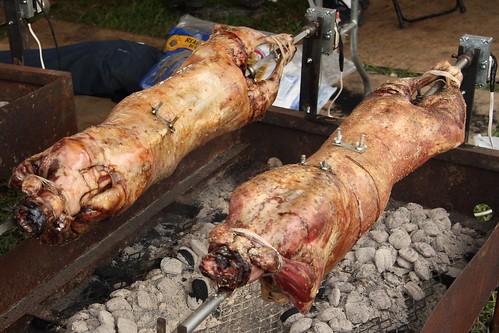
Today I had the opportunity to visit one of the great Greek Wineries in the DOC region of
Naoussa.
Boutari Winery produces wine from seven significant wine producing regions and features both noble varieties (syrah, cabernet, merlot) as well as little known indigenous grapes. Vasilis Georgiou, one of the vintners at Boutari, was gracious enough to give me a private tour and lead me through a tasting of a number of the recent vintages. The goal of the tasting was to familiarize myself better with a range of Greek grape varieties but principally to explore a specific grape with great potential: Xinomavro.

Cold Steel
I first became interested in Xinomavro wines after having a bottle at the restaurant Pylos in New York this summer. A 2003, which is purported to be an excellent year, was bright, exciting and provided an insight in the power of these little known grapes. Much like Pinot Noir in terms of body and color, the wine shines when produced by refined and knowledgeable individuals. Red berry notes dominate the wine but also typical are "green" notes as well - grass and mint, which is evocative of Barolo.
Boutari is one of Greece's oldest modern wineries and has become very well known for its white Moschofilero from the region of Mantinia in Peloponnisos. This white wine is widely available at many larger wine shops in the United States. Apart from this very well known wine (900,000 liters are produced per year) in Greece, at least, the Xinomavro wines from Naoussa are the best known and most well-renowned.

Raising the bar.
A grey and misty day, my cousin and I set out on the hour-long ride to the winery, situated north of Thessaloniki, in his convertible, which was arguably not the best car for the job. No matter, as we arrived safely around 1:30 and were more than ready to taste a few wines. Vasilis met us in the large and beautiful tasting room and led us on a tour of the facilities. The facilities were large and impressive and handle the bottling of the majority of the Boutari wines. What was clearly evident during the tour was not only the meticulous, loving attention paid to the wine but also the attention to innovation - just installed was a french oak fermentation tank solely for experimenting with new blends and cutting edge viticultural methods. All of the wines are currently fermented in stainless steel fermentation tanks, which lend a clean, crisp characteristic to their wines but lack some of the characteristics of wines fermented in oak vats.

If I could have only photographed the aroma!
The wine vaults were vast, with approximately 3,000 barrels of primarily French oak (but also some American as well) and smelled heavenly. Boutari's selection of their vintage wines is also vast - the most extensive in Greece and one is able to purchase across a large range of the classic Xinomavro vintages at a very reasonable cost (1990, an excellent vintage, was 30 euros per bottle).

Want to see some wine disappear?
After the tour came time for the tasting. We tasted young wines - ranging from 2003 to the most recent 2008 vintages - from five Boutari's wineries situated around Greece. The best wines were round, full, and delicious. The flagship, workhorse red, Naoussa Boutari 2007 had great potential but didn't have time to open up. Vasilis said that 2007 will prove to be an excellent vintage; I think it will come around as time passes and I will be looking forward to tasting the Grand Reserve when it comes out. The Grand Reserve 2003 was excellent. The additional time spent in the barrel and bottle softened the tanins and balanced the acidity which are characteristically high with Xinomavro. Again the wine needed decanting to open up but it was delicious (I bought a case). The last wine in the tasting was a horse of a different color. Skalani, from Crete, was a big, juicy wine that really shined. 50% Syrah and 50% local grape Kotsifali, it was familiar yet mysterious. It wasn't overly jammy and would have done well next to any red meat and really shown with the typical red fruit notes of Syrah but with a finish that was interesting, dominated by undertones of chocolate and oak. This wine won top honors at the Thessaloniki wine expo this past year.
All said and done, it was an excellent day at the winery. I had a wonderful opportunity to taste a wide selection of Boutari wines, curated by Vasilis and his team. We left the winery, cases in hand, for a late lunch in the town of Naoussa, which had been completely enveloped by clouds, fog, mist, and a fine drizzle. In the restaurant's warm womb we washed down baked fava beans, cooked feta cheese, and fresh grilled bread with lashings of delicious, fresh house-made Xinomavro. With drove back to Thessaloniki extremely contented with our experience: mission accomplished.
Feel free to read up on Greek red grape varieties
HERE













